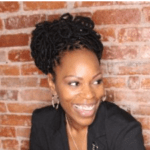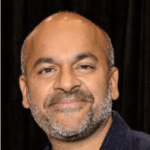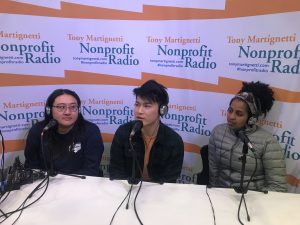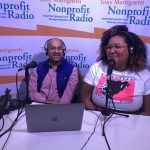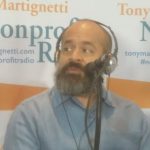
Danielle Fox, Ellonda Williams & Raj Aggarwal: Measuring Equity
We’re kicking off the 2022 Nonprofit Technology Conference (#22NTC) conversations, with a discussion of how equity can be incorporated into your nonprofit’s performance measurement. Sharing their collaboration are Danielle Fox at Union of Concerned Scientists, Ellonda Williams with B Lab and Rajneesh Aggarwal from Provoc.
Listen to the podcast
Podcast: Play in new window | Download
Get Nonprofit Radio insider alerts!
I love our sponsor!
![]() Turn Two Communications: PR and content for nonprofits. Your story is our mission.
Turn Two Communications: PR and content for nonprofits. Your story is our mission.
We’re the #1 Podcast for Nonprofits, With 13,000+ Weekly Listeners
Board relations. Fundraising. Volunteer management. Prospect research. Legal compliance. Accounting. Finance. Investments. Donor relations. Public relations. Marketing. Technology. Social media.
Every nonprofit struggles with these issues. Big nonprofits hire experts. The other 95% listen to Tony Martignetti Nonprofit Radio. Trusted experts and leading thinkers join me each week to tackle the tough issues. If you have big dreams but a small budget, you have a home at Tony Martignetti Nonprofit Radio.
View Full Transcript
Processed on: 2022-04-07T03:38:20.301Z
S3 bucket containing transcription results: transcript.results
Link to bucket: s3.console.aws.amazon.com/s3/buckets/transcript.results
Path to JSON: 2022…04…586_tony_martignetti_nonprofit_radio_20220411.mp3.154526215.json
Path to text: transcripts/2022/04/586_tony_martignetti_nonprofit_radio_20220411.txt
mm hmm. Hello and welcome to Tony-Martignetti non profit radio big nonprofit ideas for the other 95%,, I’m your aptly named host of your favorite abdominal podcast. Oh, I’m glad you’re with me. I get slapped with a diagnosis of pollen, euro Maya’s itis. If you inflamed me with the idea that you missed this week’s show measuring equity, We’re kicking off the 2022 nonprofit technology conference conversations with a discussion of how equity can be incorporated into your nonprofits, performance measurement, sharing their collaboration are Danielle Fox at Union of concerned scientists. Alando Williams with the lab and Rajneesh Agarwal From provoke On Tony’s take two, you’re responsible for donor relationships. We’re sponsored by turn to communications pr and content for nonprofits. Your story is their mission turn hyphen two dot c o here is measuring equity. Welcome to tony-martignetti non profit radio coverage of 22 N T C. By now. You know what that is. You know that it’s the 2022 nonprofit technology conference, you know that it’s hosted by N 10 very smart savvy organization helping everyone use technology in their social change work. You know, all this. What you don’t know is that my guests now are Daniel Fox, Alando Williams and raj Aggarwal but now you do now you’re informed now, you know, as much as I do Daniel Fox is campaign and Science network manager at the Union of concerned scientists. Alando Williams is director of justice Equity, diversity and inclusion Jedi at B lab and raj aggarwal is president of provoke Daniel Ayalon garage welcome to nonprofit radio and and Farage welcome back. I hope I’m, I hope I’m as excited to have you back now uh, in half an hour or 45 minutes as I am now, Rogers already given me trouble before we even started recording. So I’ll have to check in with me every 15 minutes to see how my raj meter is is is jumping. Okay, [00:02:47.88] spk_1:
what about what about my tony meter? [00:03:07.24] spk_0:
It’s less important because that’s the relevance of that is raj Aggarwal. non profit radio that’s where you can measure your tony meter, but tony-martignetti non profit radio I can measure my raj meter anytime I want to. So pardon me, Yolanda, [00:03:08.51] spk_2:
it’s House Rules, [00:03:33.94] spk_0:
House Rules, House rules, get your own show essentially it was what my advice is to, to raj. Okay, let’s see, So let’s give everybody a chance to give a brief, let’s, you know, we’re not, you’re, you’re talking to an audience of 13,000 folks who are already in nonprofits. So you’re you’re likely not talking to potential donors, but for a little context please, you know, briefly Danielle, what’s the union of concerned scientists about? [00:03:37.34] spk_3:
Sure. So the concern of concerned scientists is a science advocacy organization, essentially. We’re all about how do you put science and the scientific community to work for a better world. Uh, and that also means more just policies and political systems and so we’ll get into it a little bit soon but working with the justice and equity lens is fundamental for us to actually be able to fulfill our mission. Um And so that’s why I’m excited to talk about how we measure it. [00:04:33.84] spk_0:
Thank you for supporting the work of scientists. Uh it’s especially now, but please thank you. You know, science scientists, they’re I think they’re not to be marginalized and and mocked there to be central to a central to a conversation and essential in a in a rational world. So thank you for doing that, Yolanda. Please tell us about B Lab [00:05:26.14] spk_2:
you too. Yes. Um so the lab is a non profit network that transforms the global economy to benefit all people communities and planet. Basically what we do is really our vision is to create a collective vision of inclusive, equitable and regenerative economic economy. So we really come into organizations and businesses known as the corpse. Um and we certify them using our set of standards to really take a look at their organization. How are they treating them? How are they treating their community? How are they paying their staff? How do folks feel showing up as part of a member of that organization? And so collectively we have over 4000 dead corpse across the globe. Um and we all come together to really assess how to do things in a more um Jedi forward and equitable way with really um centering around economy and how do we change? How do we think about business [00:05:29.74] spk_0:
is B lab the certifying like agency or not for for B corpse? It’s isn’t where folks apply for for for B corp status. [00:05:41.24] spk_2:
You got it. That’s a really good question. So be lab, which is where I work. Um It’s part of our entire B lab global network. So we are movement. So be lab itself is the certifying body and that is where individuals kind of start um taking our basic impact assessment in terms of your organization to really assess how do you fare as it as it as it is against our current standards. Um and that kind of gets, gets your foot running in terms of getting certified to become a B corporation. [00:06:20.24] spk_0:
Excellent. Alright, thank you raj. Tell us about provoke which is spelled P R O V O C. When I first met Roger, I thought it was provocative. He corrected me. Of course it’s provoked raj, Tell us about the the agency, [00:06:29.74] spk_1:
thank you. tony So provoked is a brand, the narrative strategy and uh communications and campaign um firm that roots are that does their work through an ever deepening racial equity lens. [00:07:08.94] spk_0:
All right, thank you all again for being here. Um Daniel. Let’s start with you. Oh well, I didn’t introduce the session topic which is can equity be measured lessons from a great collaboration Danielle. It seems that you’re the you’re the organization that was interested in as you said, Centering I guess you know, walking the walk now of uh justice equity, diversity, inclusion Jedi why why did that become important to you when whenever it did versus some other time. [00:08:22.04] spk_3:
Yeah. Absolutely. Well I think it’s I think that the organization has had to do its own unlearning relearning and thinking about, you know, as we look at the political systems and systems of racism and injustice that we need to change how we do our work frankly and how we show up. Uh it’s a different definition of success if we’re going to be true to our mission and our stated values and so with that um we’ve tried to work hard and continue to continue to learn, continue to mess up, continue to make progress and continue to take steps forward. Uh, but the work that we did with provoke was specifically around our science network. So we have this network of about 25,000 scientists and technical experts that come to U. C. S. To say hey I want to grow as an advocate and get involved and put my skills to work for social and policy change now for us for us to truly be successful. That meant that we also needed to ground how we were organizing and cultivating scientists and researchers and putting their skills to work to rectify social wrongs. That includes fighting environmental racism. That includes addressing the disproportionate impacts of all the health and environmental hazards that are going unchecked that we’re trying to put science to work to help tackle. So at the end of the day, that is really what it’s about. I think we truly [00:08:54.34] spk_2:
when [00:09:42.84] spk_3:
you know better you have to do better, Right? So we needed to change how we define success. And one of the things that has been so fantastic is to see the power of scientists as authentic partners with communities most impacted by the issues we’re tackling. And so the initiative that we were working on is looking at how do we scale up the ability for scientists to join us and get active? And that was through building local teams. That’s a distributed network of now, more than 50 groups throughout the country who are getting involved, but we knew that we needed to hold ourselves accountable and learn deeply about what did it what did it mean to have inclusive teams and what did it mean to integrate a lens of justice and equity and how we did our advocate building and engagement. And so that’s where we teamed up with provoked for and that’s how we’re trying to um you know, put metrics and accountability to the progress and what we’re trying to do here. [00:09:58.74] spk_0:
Okay. And I love when you know better you need to do better. Excellent. Um Yolanda, how did how does B lab fit into this collaboration? [00:12:30.04] spk_2:
Well, there’s there’s a couple of different ways that we fit into this collaborate. So this particular collaboration uh was between um you know, as Danielle mentioned with garage um and collaborating, collaborating provoked provoked as a report. So the fun thing about that is that I worked really closely with other be corpse that are in this space. And so not only is provoked A B corp but provoke is a B corp that that works in the Jedi space that works in the equity space. And so we’re able to constantly um share learnings, share what we share what we um discovered in in our our dialogues and our policies and our practices and and from the results um of surveys and internal work that we’re doing. So we all always able to kind of like iron sharpens iron. Right? So I’m in good company um with provoking those over, over in that space to be able to think more about, okay if provoking the people up and we’re working with other organizations to really identify how do we show up what role does the lab have in that and how do we kind of take the ideas that are that are that we’re starting at the lab in this conversation while we’re trying to tackle eyes some of these critical challenges. These are global challenges. So um sharing learnings and adapting what we learned is really a way to uh drive the learning forward. And then these types of collaborations, we can learn what went well and a really fun thing is when I was even spoken speaking with Danielle like a lot of this stuff is the same thing. There’s a lot of similarities in this realm and I think what it does that drives the, the understanding that Jedi is everybody’s job, equity, bility is everybody’s job there. It doesn’t matter what your role is, right? I’m quote unquote an expert, I didn’t give myself that title, right. People see people in the space and we give each other these titles, but we’re all accountable to this work. We’re all accountable, we’re showing up differently and I love what Danielle said as well around when you know better, you do better because then that means that you have to think differently and so our session and when we talk about how do we measure, how do we measure equity? It really starts with asking ourselves a lot of questions, why are we doing this way? You know, why do we always do it this way? Who who, who are we thinking about? Who’s in the margins and in these intersections there is no one size fits all. So something that Danielle and and and their team might do might be very different. But in the learnings of what went well, what are the challenges, what, what, what we still need to elevate um is where we can all try to come together to identify solutions that are gonna be solutions that we all can, can, can use. [00:12:42.41] spk_0:
Yeah, [00:12:43.18] spk_2:
alright, [00:13:34.14] spk_0:
now raj despite your, your pre recording admonition that I’m not turned to you too much. I promise. Trust me, trust me, I won’t, but I will at this point because you were the um I don’t know, maybe it’s not fair to say the catalyst, but you were the you were the, the, the helpers. That’s a great word, that that’s a sophisticated technical term. You were the you were the you were the drivers for the union of concerned scientists. So what should, what should nonprofits be thinking about? Like at the very early stages, what did you advise Danielle and her team, you know, at early stages to be, to be, I don’t know, assessing uh measuring or you know, given where they were at the time. You know, what was your advice at the earliest stages is what I’m trying to get at. [00:16:02.34] spk_1:
Yeah, so first of all, um I just really appreciate Danielle and Yolanda and I learned so much from them all the time and just how we show up in partnership. So I was really taking this as an opportunity to learn from them. Um I appreciate the term catalyst and also with our work with the Union of concerned scientists, I was reminding the client just the other day that, you know, the term catalyst is a is a term and chemistry, which I actually have a degree in which I rarely use and the purpose of that is a catalyst is something that helps to reduce the activation energy of a chemical process. So, so it’s going to happen anyway. But hopefully through an intervention through hopefully our team, we can maybe get there a little bit quicker. That’s that’s what a catalyst does. So I’ll take it. Um um so you know, with with so obviously part of the reason that we participated in this work is we do a lot of work on equity. And often people ask this question, you know, because of just the nature of the world. Business capitalism is are we really getting there and how can we measure it? And how can we report on it? Um and that’s obviously really important to do that as well. And so some of the things that we asked, you know, for certain scientists to do was to really think critically about why they want to change the world, how they plan to turn that into reality and what best metrics represent that success. And so for example, sometimes we would hear language from um union of concerned scientists around things like high impact actions. And so we asked them to specify what is the list of those actions or underrepresented scientists. And then we asked them to get really specific about what does that mean race, economic status, gender identity, disability. And to amplify and support. And what does that mean? And one of the big things that came up in our session with uh N. T. C. Just last week is this idea of impact and how that’s been so much that comes up in nonprofits, but we don’t really define it. So this practice that really was a whole practice of definition and then determining what tools and measures you can go about doing it. And Danielle will talk to you also about like what has happened since they started doing this and where did it work? And where did it didn’t, where does subjectivity come into this? Because some of that, so many of these things are going to be subjective through how a person might perceive what they’re actually doing. Um, and it may not be measured by a specific number. So, um, that was, that’s just one thing in here. So what the union concerns scientists did was they established six key performance indicators and 15 supporting metrics to evaluate the growth of local engagement program across the US, um, including an equity specific KPI [00:18:39.74] spk_0:
it’s time for a break. Turn to communications. Here’s the ways that they can help you media relations. You’ve heard me talk about this, that’s the relationships building those relationships with outlets like the chronicle of philanthropy, the new york Times Market watch fast company Washington post. All places where turned to clients have gotten placements, content marketing. If you’re interested in white papers, Your annual report falls into that. You want them to do research for you. Maybe research on a program and then publish that research for you to share with donors, foundations. You know, other supporters research. They can do research for you and write about it. Speech writing, ghostwriting training on media management, media relations website. They can build website for you website creation redesign. I haven’t talked about that one. But yes they do that too. So all you know media relations, content management thought leadership web social media social marketing turn to communications, right? Your story is their mission turn hyphen two dot C. O. Now back to measuring equity. Raj said this is all very subjective. I was thinking ethereal you know, but it’s it’s uh it’s it’s it’s hard to it’s hard to grasp however you you know how every whatever word you use to describe it. So Danielle, you know how did the U. C. S. Start to start to start to grasp it. You know, start, I mean eventually you end up with like raj said, you know, six KPI s and 15 supporting metrics, you know, whatever. But you know, how do you take that incrementally with this? Very subjective these very subjective concepts. [00:21:57.84] spk_3:
Absolutely. Yeah. I’m happy to I’m gonna try to discuss it. It might sound a little messy when I discuss it but that’s so actually symbolic of what the processes and the fact that it’s just messy. Let’s do it. Oh no, it’s fine. Honestly if we’re going to talk about equity, it should always be a little uncomfortable. Um so one of the uh you know, one of the very first things I think we did with roger and the team and I really appreciated it was to just hold space for dialogue about why this even matters and what impact looks like. And I don’t mean that vaguely, we had to do a tactical visioning exercise. What described, what does impact look feel smell like when you see it, when does it take place? Um, and I think that that was so critical because we took the time to ask ourselves questions before thinking we knew anything just like Yolanda had said. Um, and so it was the time to ask ourselves those questions and overlay that with our theory of change. Why are we even saying that these local teams need to be organizing with the commitment to equity, What is equity scientist organizing really looked like. And so we held some time to really build that, which was so critical because it ultimately served as a compass for when my team of organizers waited through all of the possibilities of things we could look at and measure. And we’re from a science based organization. So you might imagine we are curious souls that want to learn a lot of information and bless rajan their team. They sat with us through it and said, well it sounds like you’re interested in your heart is telling you you need to know all of these things that might have something to do with it. But at the end of the day when we just talked about that compass of what does impact actually look like? What are the most fundamental indicators that you can consistently track that will tell, you will do the real learning of letting you know if you’re making progress or not. And so it was really the process of starting big and messy and then running through all sorts of variations of how we may or may know whether we are in fact grounding equity and inclusion in our teams based organizing and then painstakingly. But we had we built good trust along the way. So that was so critical um narrowed down to core um things that we were going to measure. So we ultimately had two of our six core keep key performance indicators that helped us measure three things, diversity of the team’s inclusive practice of our team leaders and how they are building and running those teams and the members education and engagement in terms of what is explicitly addressing equity or amplifying underrepresented upper underrepresented voices and the issues that we’re working on. And we had to define those throughout the way to be able to measure that. So that was a little bit of the process. [00:22:06.04] spk_0:
You were able to capture those three Concepts in two Kpi s. [00:22:46.24] spk_3:
Yeah, we we collected we collected for a few different things. So that is, you know, a number of instances where underrepresented scientists were supported or where partners were grounded in the work that uh some of the team members were um, taking up, uh, that also includes things like number of teams. What is the diversity in the makeup of that team and discuss the actual practices and how you’re running those teams. So we did that through some collection of different survey questions which we can dive into a little bit later. It was an iterative process. I’ll tell you that much. [00:23:06.94] spk_0:
Yeah, no, I can tell for sure. And and and just for some context, I guess, how does this relate then to um, performance measurement? Like is this, is this is this drill down to individual employees or volunteer? No, I don’t know. It’s volunteers or employees like performance evaluations. [00:24:23.14] spk_3:
Yes, that’s a good question. This for us is more about impact measurement. Um, and so the reason why we did this all along is to make sure that the data, we’re going to need to collect data about how these local teams are working and building. And it seems fundamental to us to make sure that equity inclusion were part of those because we were talking about this earlier. You manage what you measure, right? And so we needed to make sure that our key performance indicators included equity and inclusion and how we were building out our program. So the whole goal of those indicators are to help us learn as the people, the practitioners and the people who are building out this program are we actually making progress on those things that we are saying we care about and then to hold a space for accountability when we actually have to assess the growth and impact of our program. And then also just finally to invite a culture of learning both for us as staff who are trying to do things differently and for our science network members who are trying to join us in a movement to evolved scientists engagement and advocacy with a stronger equity lens. So it served more of a learning and accountability versus a performance performance evaluation. [00:24:46.04] spk_0:
Okay. Okay. Um Alondra, your you wanted to take away, you know, you wanted to learn lessons takeaways like what, what are you hearing as as Daniel is describing this? [00:27:56.34] spk_2:
Ah what I’m hearing is excitement, right? I’m hearing, I’m hearing alignment. Um uh we, we talk a lot about accountability especially at black. So, so um when you’re thinking about KPI S and I’m something that Daniel said around like you when you’re measuring, like that’s what you’re focusing on, your focusing on what you’re measuring. And so if you’re not measuring something that is a clear kind of like red flag of like if you’re not measuring it, you’re not tracking it, you’re not paying any attention to it. Um and so you’re measuring what really matters. And so it’s an outward depiction of what an organization truly matter, what matters to an organization, look at what they’re tracking and look at what they’re measuring. Um and so as a network B lab and we have all these reports, thousands of people were measuring what matters. But how are we if we’re trying to build an inclusive economic system and business is at the center of that? How do we do that? How do we have conversations with people? I might be an expert in the area. Um and raj talked about his degree and we’ve got we’ve got scientists and I’m not a scientist, right? Ah And so how do we educate people around how to approach their job? A lot of times we have conversations around Jedi and someone will say what you’re the Jedi expert? Like why do I have to do that’s your job? And I say, but it’s not, it’s not. Um we talk about what makes a leader, what makes a good business, what makes a leader someone you want to follow? Um if you’re doing things and how do you make people feel, how do you make other businesses feel? How do you make your community feel right? And so if we are we’re all knowing better and doing better and sharing this information, how do we take this information and have further dialogue around things like our standards are certification requirements? How do we measure what matters? And if we have conversations with our community that helps us understand what are the needs of the most marginalized in order to center in order to think more Jedi forward. We have to always ask ourselves who are the most marginalized. Um who who who are we not thinking about? Who are we creating barriers for a lot of times. We look at the outcomes and what’s gonna happen. But we don’t ask ourselves the question around, have I created a barrier? And more specifically, have I created a barrier for a representation that is traditionally or historically marginalized? And the only way to do that is to ask questions. Right? And so what Daniel said around dialogue. So we’re learning around listening to the community. What are the challenges that organizations are having when they’re trying to approach? Not only their KPI but whenever they’re approaching their supply supply chain, whenever they’re approaching their community communication, whenever they’re working with community, uh what are the challenges that they’re experiencing? Because if we’re looking at that, that is the information that we can use to build more resources, more uh more policies that are actually going to help uh create equitable outcomes. It’s gonna help our tools and our programs and just general accessibility of the work that we do. [00:28:17.34] spk_0:
So, so Alondra is this is this work that’s going to be um spread among the b corp Among these 4000, you know, be corpse that that they’re going to start to be held 2, 22 Jedi standards, as I don’t mean, I don’t mean tomorrow, but tomorrow’s Saturday. But I don’t mean [00:28:26.24] spk_2:
monday monday [00:28:34.34] spk_0:
either. Give yourself some time. But um, this is this is this is this eventually going to be part of b corp I don’t know the approval or [00:28:37.74] spk_2:
certification, [00:28:39.02] spk_0:
certification, [00:30:08.34] spk_2:
certification and verification. Um, so let me clarify so a couple of things we already tracked. So Jedi Jedi and equity bility, um, inclusion. These are already built within our standards. Um, but we are an organization, like many other organizations where trucking along and we’ve been in existence for some time and so, um, what we used to do to measure the past or not the things that we’re going to be able to measure the future as things are growing and as things are changing. So why we have always measured Jedi, why? We’ve always measured things like what’s the difference between your highest paid individual and the organization and the lowest paid individual in the organization. And the farther across that spread is indicates that there’s less equitable ability built into your systems in the organization. So we already looked at things like that. But what we’ve done in this past year is we’re really, really looking at all of our requirements. We’re looking at how we measure what truly matters. And so how do you measure equity? What is, what is that question that we write in the basic impact assessment that is gonna give us the information that we need to track how well an organization is doing identifying those questions if it’s difficult identifying those parameters were global. So it’s not just us, it’s not just Canada, I mean we’re a global network and so we have a lot of things to take into consideration. Jedi is not one size fits all, um, something that one global partner might do might not be suitable in another region of the world. So we are constantly challenged the lab Global with creating standards that are actually going to be not only accessible, but something that’s going to translate across the globe. So that’s why it’s important for us to ask lots of questions ourselves. [00:33:34.04] spk_0:
It’s time for Tony’s take two. You’re responsible for donor relationships. What do I mean, I’m talking about keeping relationships strong, moving relationships forward. I’m also talking about when there’s been a solicitation not lettering, not letting, not lettering, not letting that solicitation sit fallow, but you follow up on solicitations right? You never want to have a solicitation hanging out there that looks like you didn’t take the thing seriously to begin with. So it’s your responsibility to keep relationships strong and moving forward with your donors. You do that in ways like remembering milestones, birthdays, anniversaries, uh, the anniversary of their very first gift to the organization. Their 20th gift to your nonprofit, their 50th gift milestones like that. Um, so milestones in their personal lives, but also related to your nonprofit, keeping in touch with just, you know, handwritten notes, phone calls where it’s appropriate. Not every donor wants phone calls. I realized that however they want to be communicated with keeping in touch in those ways, email phone notes. Keeping relationships strong and moving forward. This is your responsibility as the leadership, as the fundraiser, as the board member involved in donor relationships and fundraising. It’s not your donors responsibility to keep in touch with you. It’s your responsibility to keep in touch with your donors. And that’s what I mean by keeping those relationships strong and moving forward. That is Tony’s take two. We’ve got boo koo but loads more time for measuring equity with Danielle Fox, Alando Williams and raj Aggarwal, Danielle. Let’s talk about leadership by end. I don’t know if, you know, maybe maybe it wasn’t an issue for the the union of concerned scientists ceo necessarily or you know that c c suite level, but there must have been leaders at some at some levels in in U. C. S. That were um, I don’t know at worst, you know, unwilling at best unaware and and and so for either reason, you know, not not accepting what you C. S. Was trying to do. How do you whatever management level we’re talking about? How do you what’s your recommendations for getting that kind of buy in among leadership because it’s it’s essential otherwise this work is going nowhere, you know. So what do you recommend there? [00:33:37.34] spk_3:
Oh that’s such a good question. I will try [00:33:39.69] spk_0:
To finally only took 29 minutes. Almost all right. [00:33:43.25] spk_3:
Yeah. The other ones were no, you’re [00:33:45.83] spk_0:
suffering a lackluster. There’s no question about it. There’s no question. [00:33:52.24] spk_3:
I uh I’m happy to to try to take a crack at that. Um and but also I’m really interested with uh with what Yolanda and Roger have that, so if you don’t mind, I’d love to have like that be a team effort. Um [00:34:05.13] spk_0:
but [00:34:21.54] spk_3:
but I’d say, you know, there there was no sort of, there was no overt objection to it. It was just more of a sense this understanding that when you want to track when you redefine success and you want to meaningfully track that, that means we’re gonna have to have a hard look at our systems and our status quo of how we usually track and monitor things and to to unpack some of that and potentially to have to change um [00:34:41.64] spk_0:
what [00:34:42.02] spk_3:
we’re defining as success and what even systems or tools or capacity we have to be able to then consistently monitor and learn from it. So I would say that it wasn’t, there wasn’t a particular opposition, it was just more of a question of, [00:34:59.74] spk_2:
well, [00:37:28.33] spk_3:
what does new success actually look like. Uh and I think for that the approach was more just creating an authentic space for learning that no matter what level you are in an organization of space to ask critical questions together and to relearn and re envision together and have really difficult conversations about what we might need to be doing differently and why that’s important for what contribution we’re trying to have is so fundamental and that it doesn’t from my perspective and maybe this is my personal opinions towards like hierarchy were all at the end of the day, people with different ranges of responsibilities that hopefully if we’re showing up at that meeting and that conversation and good faith want to do better. Um, and so maybe that’s naive of me perhaps, but I think some of it was just creating a lot of spaces without particular judgment, but very honest, candid conversations about um what what’s different, what does success actually look like that needs to look different from how we’ve defined it before and then um what do we need to do as a team to be able to outfit ourselves to authentically monitor that and hold space to check back for whether we’re really um meeting the markers that we have and if we aren’t how we’re willing to adapt. And so maybe this is my own opinion every I’m an organizer at heart. So everything’s a campaign and part of that is a mix of sure pressure, but also persuasion and bringing people on board to join in a collective vision with you and see their role in it. And so I think there’s a lot of conversations along the lines of that and then a lot of conversations about if we’re going to do more of this, what are we going to do less of and having to make difficult decisions about what we prioritize and actually invest in. Uh those were difficult conversations and that is a okay. And so just giving yourself the time to work through that so that when it comes time to start up these key performance indicators and this initiative with equity and inclusion as barometers for progress that we’re all on the same page and were brought in and we know how we’re going to do it. [00:37:57.13] spk_0:
Well if any of that was naive then I share your naivete. So I don’t think it was, but that’s because I’m with you all right. Uh Irlanda, do you wanna Danielle opened the door? Do you want to talk about? You know what I want to focus on leadership? Leadership buy in for Again, it could be anything from unawareness too. I don’t know. It could be blatant racism and just unwillingness, you know, at the at the extremes. What about leadership by in which again I think is essential to this work. [00:42:30.50] spk_2:
Well uh it is right, it’s not, there’s no guests, right? Uh leadership buying is absolutely essential. Um And it is going to help drive longer term change and success, but a couple of things that Danielle said makes me think like that. So I’ve had a couple of experiences. I have had a myriad of experiences, I’ve had experiences where your your stuff trying to like you’re back at the business case, right? You’re back at business case. So so for those of us in the in the Jedi, I say look at Danielle Danielle, for those who can’t see, Danielle is vigorously nodding her head. Um the business case. So when Jedi hit the scene, when equity diversity E. D. I hit the scene, um the business case was like a really big thing because when we think about Jedi, it’s really rooted in how people feel the experience that people have or lack thereof, and how those experiences create inequities that can show up in education, obviously in business um in the health care system, you know, pretty much any system that we have with that inequities can can show up in. So what’s important for us to take into consideration, how do we get this by it? And so what we had to do was is we had to make the business case which was a lot of contributed in money, right? We had to say this is this is relevant to a business because businesses that are diverse that have diversity of thought, not just the color of someone’s skin, diversity of thought, thrive, They do better. And there’s years of evidence for that. Um so long before we really were having conversations about inclusion and justice and how people feel we were having conversations around your business should do this and it’s worthwhile for your business because you will get a return on your investment financially. Um, and I love the fact that we’re kind of shifting away from that and uh I’m having a lot less of those conversations and a lot more conversations of I know that there’s a problem. I recognize that something must be done. I have no clue where to start or I know that there’s a problem. I just don’t see it, help me learn how to see it and in that work it’s very, very difficult and it takes a long time. And so I’m lucky that in my current experiences I have with leaders that that know that there’s a problem and want to do something about it. But the struggle sometimes is what one thinks is the solution to the problem is not the solution to the problem. So what I see happens is you get the buy in. Sometimes you might have an organization where you have buy in from leadership. However, when you talk about what the actual solutions are, that’s when there is discrepancies, there’s discrepancies on whether or not we can actually solve this problem by by enacting that solution. And so we have to have a lot of conversations around resources and for me, I’m able to really elevate vision right, what is the vision of your organization? So I could ask that all the time. Staff say how I would love for my organization to put E. D. I first right to elevate equity. What is the conversation that I need to have with my manager, with my boss, with my supervisor, with leadership? How do we have this conversation? And I really challenge you to kind of like look at the vision and I’m encouraging those who really feel like they want to be a part of organizations that are putting this type of work forward. Take a look at the vision of the organization that you work at. We have an inclusive equitable regenerative system. So I was able to say if we want to do this work, we have to think about equity, but we have to take into consideration if we know that we’re not only going to get a return on our investment are people are going to feel better. They’re going to want to be here. They’re going to um, feel valued being here. You don’t have to work your employees to the bone to get dedication from them and treating them like human beings is how you’re actually going to be able to work together to create not only solutions but a space where everyone can show up as their true, authentic selves and feel good about being at work. Um, and we’re not there yet. You know, we’re not there were not there at the lab right? We still have these challenges internal to our organizations. Just like other organizations. [00:43:03.80] spk_0:
I am gratified that you’re having fewer conversations that are based around money. You know, bottom line, that’s, that’s encouraging in the end it is all it is all about the bottom line but that you’re having fewer conversations that are rooted in that, you know, that are, that are explicitly about why it’s better for your, you know, how it will help your bottom line um, Raj. I’m only turning to you because Danielle suggested that you might want to comment on this. So uh would you, would you like to on the, on the buy in? We just have about 10 minutes left or so. [00:43:18.30] spk_1:
I don’t have anything more to add than what these folks do. [00:43:22.05] spk_0:
Yeah, [00:43:22.68] spk_1:
I did share though, Danielle with Lane frisco and Denise done. Um how happy it makes me here? How happy it makes me to hear you share this in this way. So thank you so much. [00:43:35.90] spk_2:
Oh, [00:43:36.50] spk_0:
you’re thanking me. [00:43:37.80] spk_1:
Yeah, I’m always thinking tony and I’m thinking Danielle and of course dr Williams all the time. [00:43:54.20] spk_0:
Yeah. Well, these voices, right, the conversation needs to be elevated and I can help deliver it to another 13,000 folks. So, um Yolanda, I have a question um, I am, I am, I am, I am I because you’re the Director of, of Justice Equity diversity inclusion. I am. I am I to 2019 If I refer to D e I [00:44:07.89] spk_2:
am [00:44:08.83] spk_0:
I am I if I’m if I’m three years old, if I’m living in the past. Tell me and I’m asking you d i is what it used to be. But now I see Jedi more, I see Jedi emerging, I know [00:46:07.58] spk_2:
are you 2 2019? Ah that’s that’s a lot of pressure to put on. Maybe you’re not there and you’re jeremy Tony and I respect that. But I will say I will encourage folks that are still really focusing on like, quick. The fastest Jedi training that I ever can give right is um, the justice aspect is is really, really important because it takes into consideration where we are, And it’s really difficult for us to look at how the existence of things as they are right now in 2022 without paying homage and respect to the fact that there is a very specific reason why we are facing the inequity that we face today. And so it’s important for us to bring that element to the conversation, because then we can say the reason there’s a really good reason why we need to have a conversation with our HR department about whether or not this level to position needs to have a bachelor’s degree, and that is that role actually necessary? Or have we are we a product of a of a society that folks of privilege and power decided what was necessary in order to be able to succeed again defining what that success looks like. And so we are just perpetuating that same ideology, even though we know that’s not true, and so how do we really root equity diversity and inclusion in in, you know, in a way that allows us to change from the way things used to be with recognizing that it’s not going to get us to where we want to go. So that’s why justice is a really key component. But again, some folks aren’t there in their, in their Jedi journey. Um, and I aspire okay, [00:46:43.58] spk_0:
well, and I regret that I personalized it. I got, but I was thinking, I was thinking to myself, but you know, because I don’t mean to put pressure for Jedi, I love Jedi Jedi warrior. You could be a Jedi warrior. Um, yeah. Okay. Okay. Um, let’s see Danielle, why don’t you, why don’t you leave us with some, uh, inspiration if you like or something that you think we haven’t talked about yet doesn’t have, doesn’t have to be, uh, doesn’t have to be grand inspiration. Maybe just something that we haven’t talked about yet that you’d like folks to know about, uh, this work, this journey that that you see us went through. I’m gonna give you the chance to, uh, to leave us. [00:48:52.87] spk_3:
Sure, you know, it, this is gonna sound a little atypical, but I think the for me, what’s been inspiring is that we’ve already learned, What isn’t working from what we did with provoke. Don’t take that personal rush. I mean, that is a wonderful wonderful thing because what weird doing is we’ve built in an invitation to ourselves as I would invite our advocates and any other organization that um is questioning whether they um have the knowledge or expertise to deepen equity and justice in their work and have to measure that. Um I think we’re a perfect example of organization that doesn’t have a deep expertise in this, but still wants to do it and is trying to do it, had built out something that I think really has helped ground us to be able to see how we need to keep improving. Um and that, for me is uh pretty inspiring because Ellen and I were talking a little bit about this before very often this can feel like an such a high stakes topic that can sometimes paralyze people from investing in it in taking steps. And I think the inspiring thing here is we’re already learning in the first couple of years of using these KPI s ways we can organize the local teams to to be a little bit better and more thoughtful in justice and equity, and we’re also learning that um there’s opportunities to reiterate and and strengthen our key P. I. S. That is an invitation for more learning and accountability, and for me that’s pretty, pretty exciting because this is ongoing work. I don’t think there’s gonna be a year that you see us as check we are an anti racist organization, it’s going to be ongoing work, and that’s exciting. [00:49:21.27] spk_0:
Perfect inspiration. Thank you. And I realized that uh I made a mistake, Yolanda, I’m gonna let you take us out because B Lab, the lab is in this for takeaways. What what you what you can share with your your your 4000 certified companies. So you take us out with some with some takeaways. [00:50:59.06] spk_2:
I love that. Um don’t let perfection be in the way of doing something right. Doing doing nothing is never good enough. So I love what Danielle said about a moving target as well. Um lean into uncomfortable that we don’t know what a utopian world looks like. We do not know what an equitable world looks like. We don’t know we haven’t had it yet. That’s the beauty and all of this is like we can imagine whatever we want and so be a part of what the new normal looks like. Step up and take apart to stake your claim because we’ve all we are all a product of of systems that were created before we got here. We are in a unique juncture in society in history that we can take a part in what success and the new normal books like moving forward and we can create systems that actually are inclusive for everyone that allow everyone to succeed regardless of where they were born, what they looked like, their social and economic status, um sexual orientation. We have a weird and unique space that as our leadership and when I say leadership, I’m not just talking about organizational leadership, I’m talking about in the world humans and and society members who have been a part of making decisions for a long period of time. That shift of power and influence is shifting and we’re all getting apart and we and so this is a unique opportunity, don’t squander your opportunity to be a part of something different for your Children, for our future for youth. Um we get one shot. Um and and this is gonna be, this is gonna be shaped the next 500 years of society. And so I want to take, I want to encourage everyone to kind of step up to the plate and and take ownership of your part in what the future’s gonna look like for others. [00:51:45.46] spk_0:
Perfect, thank you. That’s Alando Williams, Director of justice, Equity, diversity and inclusion at B lab, also Daniel Fox Campaign and Science Network Manager, the union of concerned scientists and the other person around was is raj Aggarwal, president of provoke who asked me to not focus on him too much. So I took him at his word. I assume he was. I assume he was honest when he’s when he made that recommendation, made that made that request, I should say so. [00:51:50.41] spk_1:
tony what do you think? Don’t you think it was better to focus on Dr Williams and Danielle. [00:52:03.35] spk_0:
I do, but I’m I’m disappointed that you didn’t expect me to do that anyway. So little faith after the third time on the show and still still thinks I’m an underperformer. Thank [00:52:10.62] spk_2:
you like I know how to do my job and I didn’t, I didn’t need you, but thank you, thank you. All right, [00:52:31.55] spk_0:
maybe the fourth time if there is 1/4 for you, I’m not sure I would say anybody wants to be on nonprofit. radio Uh, don’t partner with Raj in 2023 because you’re greatly reducing the likelihood of being of being selected. Uh, Alondra Danielle raj, thank you very much. [00:52:34.42] spk_1:
tony it was really nice when we received your emails, valuable [00:52:43.75] spk_0:
conversation, I appreciate it and appreciate you all for being good sports to while I uh, make fun of raj, especially [00:52:49.43] spk_3:
thank you [00:54:07.05] spk_0:
and thanks to all of you for being with tony-martignetti non profit radio coverage of 22. Ntc the 2022 nonprofit technology conference with the hope that we will be together in person in 2023 in denver colorado. Thanks so much for being with us Next week. More from 22. NTCC asking for receiving and giving feedback if you missed any part of this week’s show. I beseech you find it at tony-martignetti dot com we’re sponsored by turn to communications pr and content for nonprofits. Your story is their mission turn hyphen two dot c o our creative producer is claire Meyerhoff shows social media is by Susan Chavez. Marc Silverman is our web guy and this music is by scott stein, thank you for that affirmation scotty be with me next week for nonprofit radio Big nonprofit ideas for the other 95%. Go out and be great. Mhm mm hmm.

